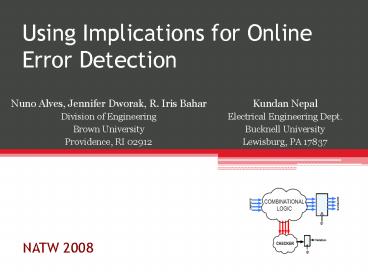Using Implications for Online Error Detection - PowerPoint PPT Presentation
1 / 18
Title:
Using Implications for Online Error Detection
Description:
Using Implications for Online Error Detection Nuno Alves, Jennifer Dworak, R. Iris Bahar Division of Engineering Brown University Providence, RI 02912 – PowerPoint PPT presentation
Number of Views:138
Avg rating:3.0/5.0
Title: Using Implications for Online Error Detection
1
Using Implications for Online Error Detection
- Nuno Alves, Jennifer Dworak, R. Iris Bahar
- Division of Engineering
- Brown University
- Providence, RI 02912
Kundan Nepal Electrical Engineering
Dept. Bucknell University Lewisburg, PA 17837
NATW 2008
2
Online error detection
- Purpose Detect transient faults that may occur
in a circuit during operation - Critical as circuits scale to smaller sizes
- Easy in memory logic
- In circuit logic not so easy
3
Common online detection techniques
- Stored pre-computed test vectors in hardware
- Duplicating the computation of disjoint hardware
elements and voting on the result - Use of check bits
4
Our approach
- Find invariant relationships in a circuit
- Violations of these expected relationships can
identify errors
5
Error detection implementation
6
Invariant relationships in circuits
These relationships are logic implications
7
Error detection with implications
ERROR
n51 n81 will generate an error in checker
logic
8
How we find implications
9
We have implications. Now what?
10
Why should we remove implications?
- With all implications we can generate checker
logic for each implication. - Inefficient!
- A circuit can contain thousands of implications
- generating separate checker logic for each
implication could more than double circuit size. - We want to detect only the most important
implications.
11
Removing redundant implications
n1
n2
n9
n12
n8
n13
n3
n10
n4
n5
n11
n6
n7
12
Removing low coverage implications
- We only want implications that
- Detect many faults
- Identify hard-to-detect faults
- Cover faults not detected by other implications
- Finding these important implications requires
- fault analysis to determine the specific fault
coverage for each implication
13
Reducing the number of implications
14
Covering faults with implications
- For each random input vector, and at each fault,
the implications-based circuit operation can fall
into the following 4 categories
Case 1 Case 2 Case 3 Case 4
Error Propagates To Output ? ? ? ?
An Implication is Violated ? ? ? ?
15
Average distribution of the 4 scenarios
16
How often do we detect errors?
- Case1/Case1Case4
17
Implications with fixed HW budgets
- Given a fixed HW budget, by how much can we
reduce the probability of an undetected error?
18
Conclusions
- Practical online error detection alternative
based on implication validation - No modification of targeted logic
- Checker logic is added off the critical path and
run in parallel rest of circuit. - For several circuits, we can detect almost 90 of
all errors that propagate to a primary output. - With only a 10 area overhead, probability of an
error being both observable and undetected is
reduced to 11 on average































